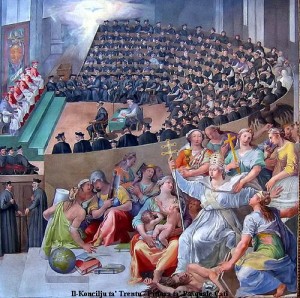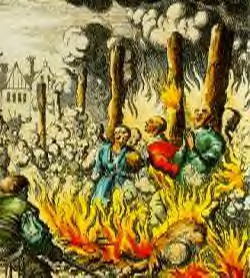The Fifth Council
The Fifth Ecumenical Council took place in Constantinople in 553 AD, and is also known as the Second Council of Constantinople. The Second General Council of Constantinople, of 165 bishops under Pope Vigilius and Emperor Justinian I, condemned the errors of Origen and certain writings (The Three Chapters) of Theodoret, of Theodore, Bishop of Mopsuestia and of Ibas, Bishop of Edessa; it further confirmed the first four general councils, especially that of Chalcedon whose authority was contested by some heretics.
Fifth Council
 After Constantine and Nicaea, Origen's writings had continued to be
popular among those seeking clarification about the nature of Christ,
the destiny of the soul and the manner of the resurrection. Some of the
more educated monks had taken Origen's ideas and were using them in
mystical practices with the aim of becoming one with God.
After Constantine and Nicaea, Origen's writings had continued to be
popular among those seeking clarification about the nature of Christ,
the destiny of the soul and the manner of the resurrection. Some of the
more educated monks had taken Origen's ideas and were using them in
mystical practices with the aim of becoming one with God.
Toward the end of the fourth century, orthodox theologians again began
to attack Origen. Their chief areas of difficulty with Origen's thought
were his teachings on the nature of God and Christ, the resurrection and
the preexistence of the soul.
Their criticisms, which were often based on ignorance and an inadequate
understanding, found an audience in high places and led to the Church's
rejection of Origenism and reincarnation. The Church's need to appeal to
the uneducated masses prevailed over Origen's coolheaded logic.
The bishop of Cyprus, Epiphanius, claimed that Origen denied the
resurrection of the flesh. However, as scholar Jon Dechow has
demonstrated, Epiphanius neither understood nor dealt with Origen's
ideas. Nevertheless, he was able to convince the Church that Origen's
ideas were incompatible with the merging literalist theology. On the
basis of Ephiphanius' writings, Origenism would be finally condemned a
century and a half later.
Jerome believed that resurrection bodies would be flesh and blood,
complete with genitals - which, however, would not be used in the
hereafter. But Origenists believed the resurrection bodies would be
spiritual.
The Origenist controversy spread to monasteries in the Egyptian desert,
especially at Nitria, home to about five thousand monks. There were two
kinds of monks in Egypt - the simple and uneducated, who composed the
majority, and the Origenists, an educated minority.
The controversy solidified around the question of whether God had a body
that could be seen and touched. The simple monks believed that he did.
But the Origenists thought that God was invisible and transcendent. The
simple monks could not fathom Origen's mystical speculations on the
nature of God.
In 399 A.D., Bishop Theophilus wrote a letter defending the Origenist
position. At this, the simple monks flocked to Alexandria, rioting in
the streets and even threatening to kill Theophilus.
The bishop quickly reversed himself, telling the monks that he could now
see that God did indeed have a body: "In seeing you, I behold the face
of God." Theophilus' sudden switch was the catalyst for a series of
events that led to the condemnation of Origen and the burning of the
Nitrian monastery.
Under Theodosius, Christians, who had been persecuted for so many years,
now became the persecutors. God made in man's image proved to be an
intolerant one. The orthodox Christians practiced sanctions and violence
against all heretics (including Gnostics and Origenists),
pagans and Jews. In this climate, it became dangerous to profess the
ideas of innate divinity and the pursuit of union with God.
It may have been during the reign of Theodosius that the Gnostic Nag
Hammadi manuscripts were buried - perhaps by Origenist monks. For while
the Origenist monks were not openly Gnostic, they would have been
sympathetic to the Gnostic viewpoint and may have hidden the books after
they became too hot to handle.
The Origenist monks of the desert did not accept Bishop Theophilus'
condemnations. They continued to practice their beliefs in Palestine
into the sixth century until a series of events drove Origenism
underground for good.
Justinian (ruled 527 - 565 A.D.) was the most able emperor since
Constantine - and the most active in meddling with Christian theology.
Justinian issued edicts that he expected the Church to rubber-stamp,
appointed bishops and even imprisoned the pope.
After the collapse of the Roman Empire at the end of the fifth century,
Constantinople remained the capital of the Eastern, or Byzantine,
Empire. The story of how Origenism ultimately came to be rejected
involves the kind of labyrinthine power plays that the imperial court
became famous for.
Around 543 A.D., Justinian seems to have taken the side of the anti-Origenists
since he issued an edict condemning ten principles of Origenism,
including preexistence. It declared "anathema to Origen ... and to
whomsoever there is who thinks thus." In other words, Origen and anyone
who believes in these propositions would be eternally damned. A local
council at Constantinople ratified the edict, which all bishops were
required to sign.
In 553 A.D., Justinian convoked the Fifth General Council of the Church
to discuss the controversy over the so-called "Three Chapters." These
were writings of three theologians whose views bordered on the
heretical. Justinian wanted the writings to be condemned and he expected
the council to oblige him.
He had been trying to coerce the pope into agreeing with him since 545
A.D. He had essentially arrested the pope in Rome and brought him to
Constantinople, where he held him for four years. When the pope escaped
and later refused to attend the council, Justinian went ahead and
convened it without him.
This council produced fourteen new anathemas against the authors of the
Three Chapters and other Christian theologians. The eleventh anathema
included Origen's name in a list of heretics.
The first anathema reads: "If anyone asserts the fabulous preexistence
of souls, and shall assert the monstrous restoration which follows from
it: let him be anathema." ("Restoration" means the return of the soul to
union with God. Origenists believed that this took place through a path
of reincarnation.) It would seem that the death blow had been struck
against Origenism and reincarnation in Christianity.
After the council, the Origenist monks were expelled from their
Palestinian monastery, some bishops were deposed and once again Origen's
writings were destroyed. The anti-Origenist monks had won. The emperor
had come down firmly on their side.
In theory, it would seem that the missing papal approval of the
anathemas leaves a doctrinal loophole for the belief in reincarnation
among all Christians today. But since the Church accepted the anathemas
in practice, the result of the council was to end belief in
reincarnation in orthodox Christianity.
In any case, the argument is moot. Sooner or later the Church probably
would have forbade the beliefs. When the Church codified its denial of
the divine origin of the soul (at Nicaea in 325 A.D.), it started a
chain reaction that led directly to the curse on Origen.
Church councils notwithstanding, mystics in the Church continued to
practice divinization. They followed Origen's ideas, still seeking union
with God.
But the Christian mystics were continually dogged by charges of heresy.
At the same time as the Church was rejecting reincarnation, it was
accepting original sin, a doctrine that made it even more difficult for
mystics to practice.

